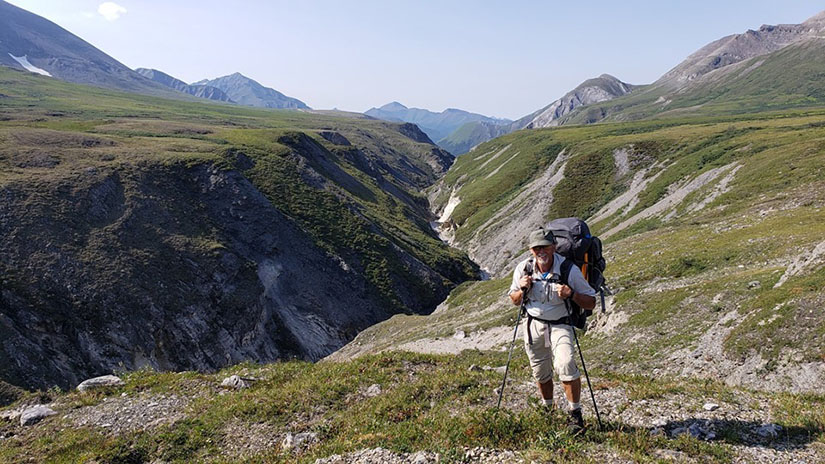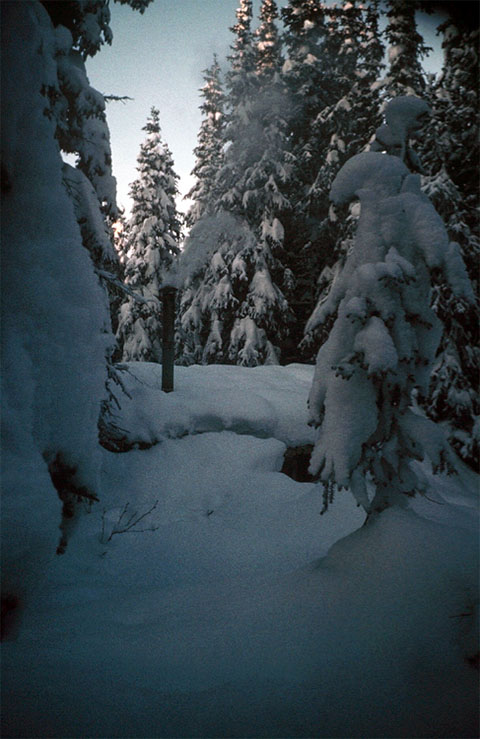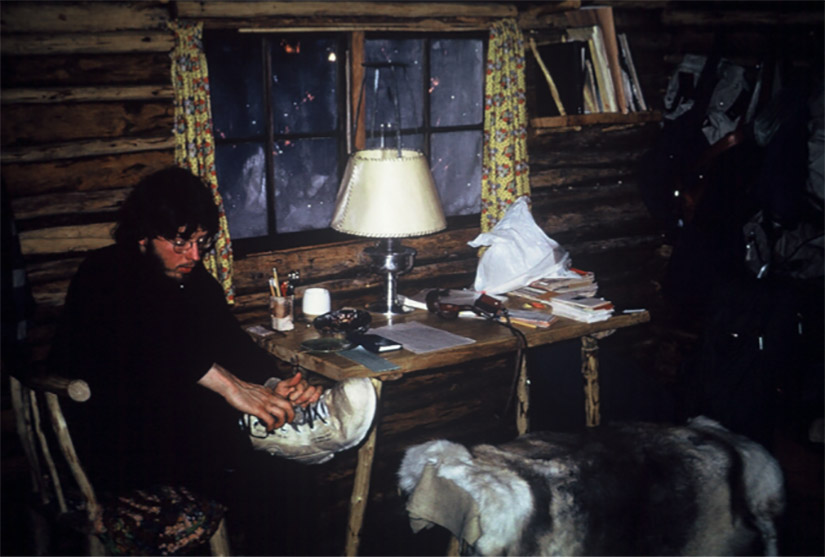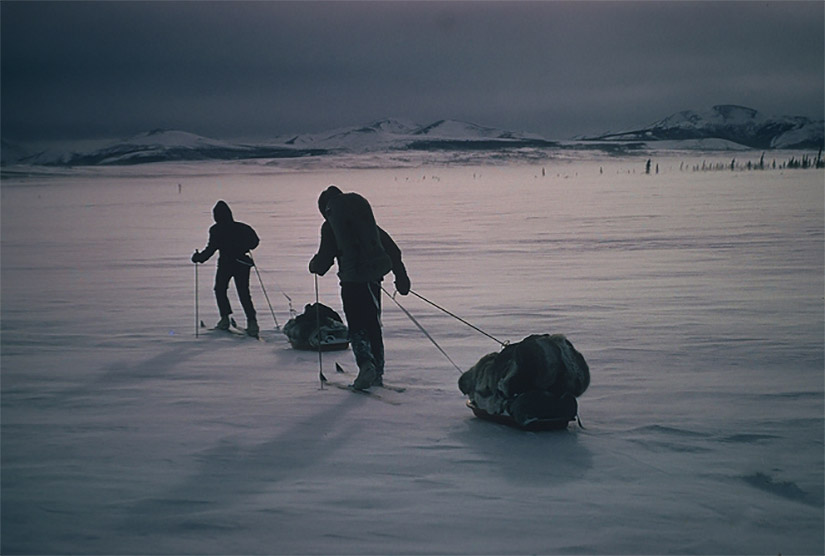A Float Through the Past: CCHRC Founder Revisits His Iglu on the River
Cold Climate Housing Innovator Sources His Inspiration
The paths to clean energy are many. While some National Renewable Energy Laboratory (NREL) researchers were building wind turbines back in fifth grade, others followed a more circuitous route to the laboratory—coming from backgrounds in aerospace engineering, conventional energy, even art. For most, though, clean energy is more than a profession—it is a passion, a way of life, an identity. In this story, one senior NREL adviser describes his journey to working in sustainability, which began deep in the Alaskan wilderness.

Jack Hébert felt his heart fill as he floated down the river. It was not because of the splashy rapids he had been paddling through all morning, or the grizzly tracks speckling the beaches, but because of what awaited him around the next bend.
It had been almost 30 years since he had visited his old home site, and he was not sure how it would feel to see it again. The valley opened up and the familiar contours of mountains and tundra greeted his memories. Then, amid a thick stand of spruce, it came into view—the sod and log iglu (northwestern Alaska’s Indigenous Inupiaq people’s spelling of “igloo”) where he spent three formative years of his life. Thick vegetation on the roof and weathered logs marked the passage of time.

After pulling his packraft ashore, he walked up to the window and could almost see his younger self peering out: the 23-year-old mountaineer who had moved up from Washington’s Mt. Rainier, hungry for adventure.
“I realized how young I was then, and how naïve,” Jack said.
When he and his first wife, Beth, were dropped off on a remote gravel bar 300 miles from the nearest road, it felt like they were completely alone. The only settlement around was a small Inupiaq village a day’s trip away. The country was beautiful and vast. Through the eyes of two young adventurers, it was like discovering someplace for the very first time, someplace that was totally their own. But today, almost half a century later, Jack has a very different perspective.
“Now I know it was just a place I was visiting,” Jack said. “It was the home of 500 generations of Indigenous people, where every rock and stream had a name. That’s something I’ve deeply realized.”
They spent three winters exploring the Arctic valleys and mountains. They ran sled dogs, hunted caribou, and hauled water from a nearby spring, taking much of what they needed from the land. In the summer, they climbed back into a bush plane and flew south to work as backcountry rangers in Denali National Park. Jack spent long days hiking steep, brushy terrain to map out wilderness areas, and hauling supplies by dog team for mountaineers who were climbing the continent’s highest peak, Denali. It was the same thing he grew up doing in the Cascade Range, but the scale of Alaska’s wilderness made his childhood experiences seem small.
Jack would eventually move to Denali Park and then on to Fairbanks to become an award-winning home builder, later founding the Cold Climate Housing Research Center (CCHRC) to come up with more sustainable ways to build. Today, he is a senior adviser at NREL.
But it was his time in the Brooks Range that set the stage for everything that followed. The Arctic served up brutal cold and blinding storms, not to mention weeks on end without sunlight. Opening the door at 40 below zero brought a new sense of clarity to what really mattered: food, water, and shelter. Walking on the river at night, under the cold moonlight, Jack would look back at his home.
“When I saw that glow from the window, this little nest of security and warmth, it really drove into me the meaning of what shelter is,” he said.

For starters, there was no such thing as a one-size-fits-all house; a building that worked in the Lower 48 had no place on the Arctic tundra or, for that matter, in a tropical rainforest. Shelter needed to be specifically designed for the wind, the soil, and the climate. The First Alaskans, he knew, had already figured out how to thrive in this climate, learning how to nestle close to the ground and use local resources for warmth, from caribou skin blankets to seal oil lamps.
As Jack designed and built more and more homes over the years, from log cabins to custom urban homes, his early respect for this Indigenous perspective informed his design approaches.
And yet as he traveled across Alaska, he saw the failures of building techniques that had been imported from southern climates—foundations sinking in the permafrost, doors that froze shut in the winter, walls that wept with moisture in the spring. And worst of all were the effects on a traditionally healthy people who were now plagued by mold and sickness and crushed by the costs of heating inefficient buildings.
That is why, in 1999, he teamed up with a group of Alaska home builders to create the CCHRC, with the mission of promoting and advancing healthy, affordable, durable shelter in Alaska and the Circumpolar North. It was a major collaboration among businesses, financial institutions, and state and federal agencies, all with a stake in housing.
Their goal, from the beginning, was applied research: not just studying wall systems in the lab or publishing reports but putting this knowledge into practice out in the real world.
“If we can show what can be done, we’re not just talking. We’re creating something you can feel and touch,” Jack said. “Others can build on that success to change the way we construct buildings in a more responsible, healthy, and enduring way.”
Over the past two decades, this research has transformed housing in Alaska. The average house built today uses 75% less energy than past-generation homes, while a growing attention to ventilation and indoor air quality has improved the health of families living in these houses. This research, in effect, allows Alaskans to continue their traditional way of life.

And in June, CCHRC moved to a bigger stage, joining NREL to tackle energy efficiency and clean energy in extreme climates and rural places around the world. For Jack, it is just the next turn in the trail.
“Our vision from the beginning was that Alaska solutions could have global application,” Jack said. “There is a lot of ingenuity in this beautiful land at the top of the world.”
Returning to his iglu last summer, Jack ran a hand over the logs, which he and Beth had harvested a few miles upriver and floated down to their building site. The house was just as cozy and sheltered as he remembered. The land was timeless, too. But in the 50 years that had passed, he was definitely different.
He had created a research center that had advanced building science, pioneered solar and geothermal power in the subarctic, and helped define the future of Northern housing. He had learned how buildings interact with the soil, the water, the winds, and the food. Now, all these years later, he understood something that the Inupiaq people had known for millennia: that in truth, a home was more than just a building.
Home is the land.
Learn more about CCHRC and NREL’s Buildings Research Program.
Last Updated May 28, 2025
